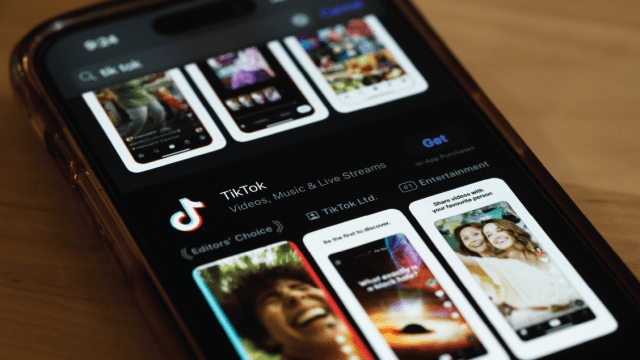
Americans increasingly have been turning to the short-form video sharing platform TikTok – both in general and for news – even as the app faces an uncertain future in the United States.
Here are eight key facts about Americans and TikTok, drawn from recent Pew Research Center studies.
Pew Research Center conducted this analysis to better understand Americans’ use and perceptions of TikTok. The data for this analysis comes from several Center studies and public opinion surveys published in 2023 and 2024.
More information about the surveys and their methodologies, including the sample sizes and field dates, can be found at the links in the text.
Some of the research in this analysis is from the Pew-Knight Initiative, a research program funded jointly by The Pew Charitable Trusts and the John S. and James L. Knight Foundation.
Explore Americans’ social media habits and attitudes
This analysis draws from several Pew Research Center publications on Americans’ use of and attitudes about social media, based on studies conducted in 2023 and 2024. For more information, read:
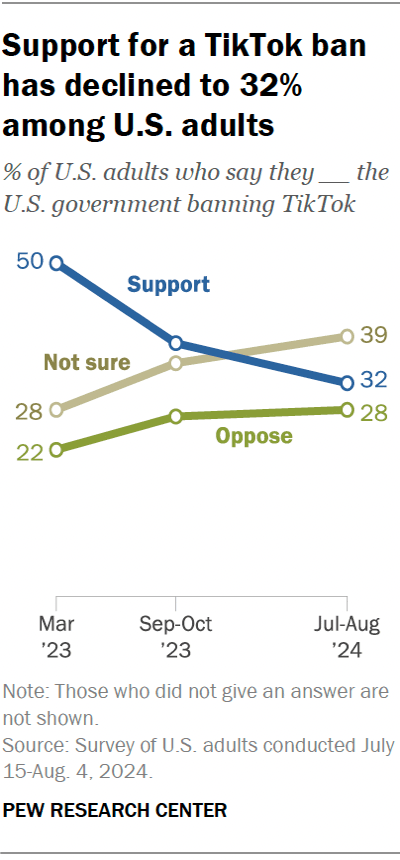
Public support for a government ban on TikTok has declined. In a summer 2024 survey, 32% of adults said they would support the U.S. government banning TikTok, down from 50% in March 2023. Another 28% said they opposed a ban, while 39% were not sure.
In that survey, Republicans and Republican-leaning independents were far more likely than Democrats and Democratic leaners to favor a TikTok ban (42% vs. 24%). But support had declined in both parties since 2023.
Half of Americans said in summer 2024 that it’s very or somewhat unlikely that TikTok will be banned in the U.S. Another 31% said a ban is very or somewhat likely, while 19% weren’t sure.
A third of U.S. adults use TikTok. Younger adults are especially likely to do so: 59% of adults under 30 say they use the app, compared with 40% of Americans ages 30 to 49, 26% of those 50 to 64, and 10% of those 65 and older.
TikTok stands out from other platforms we’ve asked about for the rapid growth of its user base. Between 2021 and 2023, the share of U.S. adults saying they use it rose from 21% to 33%.
Almost all adults who use TikTok (95%) say a reason they go there is for entertainment.
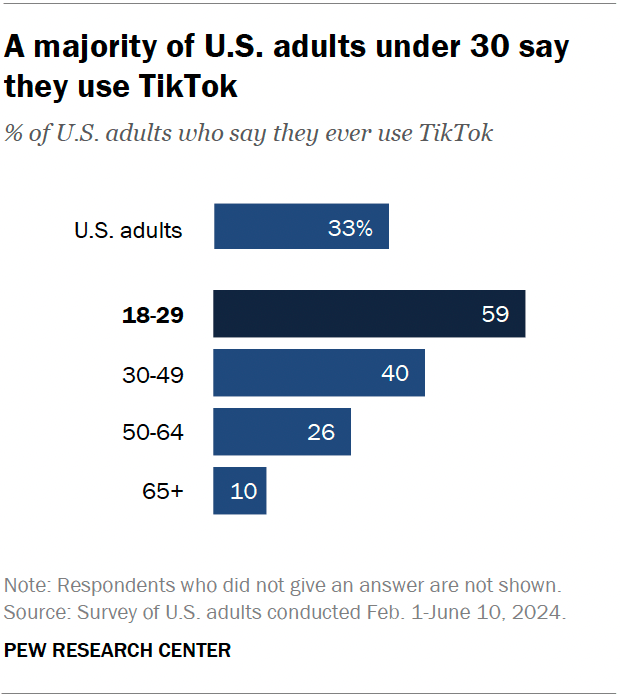
A majority of U.S. teens use the platform. About six-in-ten teens ages 13 to 17 (63%) say they use TikTok, including 57% who use it daily and 16% who say they’re on it “almost constantly.”
Teen girls are more likely than teen boys say they use TikTok almost constantly (19% vs. 13%). Black and Hispanic teens also stand out: Around a quarter (28% and 25%, respectively) say they’re on the app almost constantly, compared with 8% of White teens.
TikTok users have mixed views of the platform’s impact on democracy. A third of U.S. adult TikTok users say it’s mostly good for American democracy – roughly double the share who say it’s mostly bad (17%). However, the largest share of these users (49%) say it has no impact on democracy.
About half of U.S. adult TikTok users (52%) say they regularly get news there; that works out to 17% of all U.S. adults. While news consumption on some other social media sites has declined or remained steady in recent years, the share of U.S. TikTok users who get news on the site has more than doubled since 2020, from 22%.
U.S. adults who regularly get news on TikTok are especially likely to be:
- Younger adults: The vast majority of U.S. adults who regularly get news on TikTok are under 50. This includes 45% who are ages 18 to 29 and 38% who are 30 to 49. Just 4% of TikTok news consumers are 65 and older.
- Women: 62% of regular TikTok news consumers in the U.S. are women, while 36% are men. This gender difference is similar to the one measured among people who regularly get news on Instagram and Facebook.
- Democrats: 55% of regular TikTok news consumers are Democrats, while 39% are Republicans.
When it comes to race and ethnicity, a third of regular TikTok news consumers in the U.S. are Hispanic, while 16% are Black – higher than the Hispanic and Black shares of the adult U.S. population (18% and 12%, respectively). By comparison, 41% of TikTok news consumers are White – lower than the 60% of adults overall who are White.
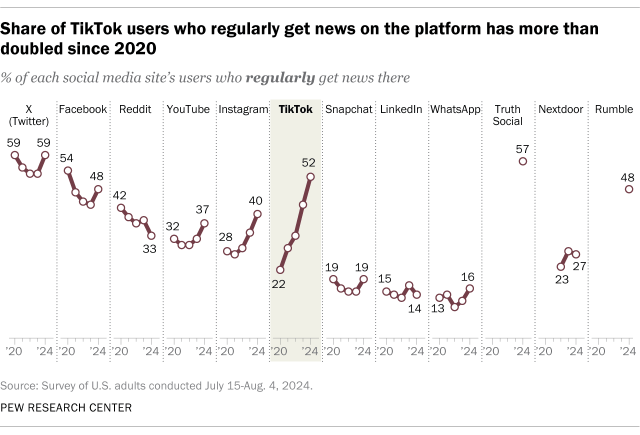
Related: Social Media and News Fact Sheet
News influencers on TikTok stand out from those on other sites, according to a study from the Pew-Knight Initiative. The platform’s news influencers differ from their counterparts on Facebook, Instagram, X and YouTube in notable ways:
- Gender: Half of news influencers on TikTok are men, while 45% are women. Among influencers on other major social media sites, men outnumber women by about two-to-one or more.
- Political orientation: Similar shares of news influencers on TikTok explicitly identify as right-leaning (25%) and left-leaning (28%). On other sites, right-leaning news influencers outnumber those who are left-leaning.
- LGBTQ+: TikTok news influencers are more likely than those on other sites to show support for LGBTQ+ rights or identify as LGBTQ+ in their account profiles (13% do so).
Many U.S. adult TikTok users report seeing breaking news content there, but it’s less common than other types of news content. These users are more likely to report seeing funny posts (84%) and people’s opinions (80%) related to current events than news articles (57%) or breaking news information (55%).
News consumers on TikTok are less likely than those on Facebook and Instagram to say they get news from friends, family and acquaintances – and more likely to get it from people they don’t know personally.
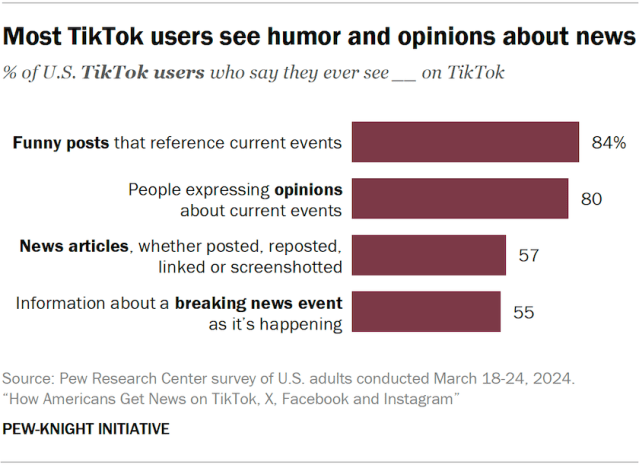
A relatively small share of users produce most of TikTok’s content. When looking at all TikTok content posted by American adults, 98% of publicly accessible videos come from the most active 25% of users.
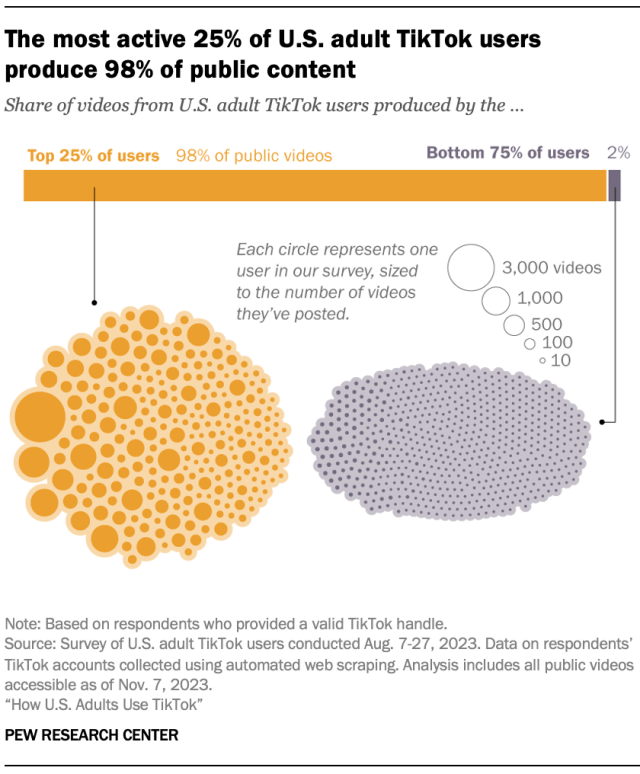
Overall, about half of U.S. adult TikTok users (52%) have ever posted a video on the platform.
Adults who have posted videos to TikTok are more active on the platform overall. These users follow more accounts, have more followers and are more likely to have filled out an account bio.
Although younger U.S. adults are more likely to use TikTok, their posting behaviors don’t differ much from those of older age groups.
Note: This is an update of a post originally published April 3, 2024.